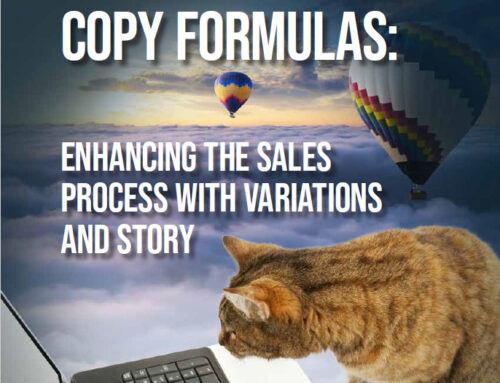Have you heard (or given) these copywriting suggestions to help improve your content?
Some are absolutely the way to write effective copy – but only if your copywriting team understands how to implement them.
Other content ideas are very difficult to implement effectively.
“Make it more conversational”
A few years ago, I had an agency head suggest to a client that their copy (that I was writing) needed to be more “conversational.” Conversational writing is the only way I write, so I was surprised at her suggestion.
So, I asked what she meant by “conversational.” Here’s what she said . . .
“We should be talking in a conversational tone using words such as ‘we’ and ‘our.’”
Um, actually that is the EXACT opposite of what good copy should do.
You want to talk TO your audience using more “you” and “your.” No one wants to read a lot of the company basically talking to itself, by using a lot of “we” and “our” (or “our company,” “our products,” etc.) That has traditionally been called “we-we-ing” all over yourself.
Conversational tone is absolutely the way every web page, blog post, email, direct mail, print ad, and social media post should be written.
“Conversational” means the way you would say something (professionally) if face-to-face or over the phone with the prospect or client.
And the best way to test it is to read it out loud. You should be using:
- Short sentences. (Sentences that are too long don’t give the reader a place to take a “comprehension breath”, just as you would need to if speaking out loud.)
- Sentences that may start with “joining” words, such as “and”, “but”, or “because.” This makes the writing sound more natural and helps to join ideas.
- Use of contractions, such as “you’re” and “it’s.” “You are” and “It is” tend to sound stuffier.
- Lots of “you” and “your” to talk TO your audience. People don’t really care about a company – they only care about what the benefit is to them.
We all read a lot of suggestions online about how to improve content and copy.
Be sure your team members (whether creating, editing, or approving copy) aren’t just using a buzzword like “conversational” without understanding what it actually means. Be sure they know how to implement it and how to recognize it.
“We need to inject more humor into our writing”
Using humor effectively is one of the hardest things to do in copy.
That’s because it’s difficult to craft a humorous message that will genuinely be seen as humorous by your target audience.
As soon as you present a pun or play on words or other humorous headline – and your audience doesn’t get it – you’ve wasted your marketing budget.
It’s also true that humor doesn’t work in every industry. For perhaps more than 10 years, my prior agency worked with banks all over the country. We repeatedly tested humorous approaches against more straightforward benefit-focused efforts. We never found that the humorous approach generated more new accounts than the direct benefit approach.
We guessed that perhaps consumers do not find financial services funny. It’s a subject they take seriously, and perhaps they respond better to more direct approaches.
I’ve seen that in insurance as well. Although we might want to try some humor, we’ve never found that the humorous approach does better than a more straightforward approach in terms of generating sales.
“Our copy needs to be lighter. We need less copy.”
Every few years, someone makes this great conclusion that “less copy” is the way to go. I’ve seen that conclusion come and go for many decades. The bottom line is this: if you’re generating leads, you can use a benefit-oriented headline, maybe a sentence or two, and then the key benefits of your offer as bullet points — and effectively generate leads.
But when you’re trying to drive a sale, your audience needs enough information to make a purchase decision. So how much copy do you need?
Have your best salesperson try to sell you one of your products – and write down every word that person says. If all of those words are needed to sell your product, they need to be SOMEWHERE.
So, you may be able to write “lighter” email copy – but be sure every word you need to close the sale appears on the landing page.
What happens when you focus more on “less copy” – rather than on providing all the relevant information your audience needs to make a decision? Your audience just goes to another website that does answer all of their questions.
Remember that telling a copywriter to focus on “less copy” is like telling your best salesperson they can only sell to a prospect for X minutes. Would you ever tell your salesperson to limit their sales discussion?
Need more help with your website content? Our new BEST-SELLING book, “The Results Obsession: ROI-Focused Digital Strategies to Transform Your Marketing” is now available on Amazon!

Learn more about The Results Obsession and see the Table of Contents
The book includes 3 chapters on copy strategy, writing specific elements like headlines, and making every word as strong as it can be. There’s also a chapter on website analysis and navigation, as well as writing website copy.
It will help you analyze your website step by step, so you can target the areas that need improvement.






Leave A Comment